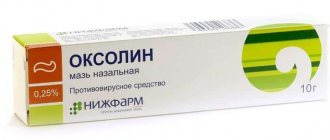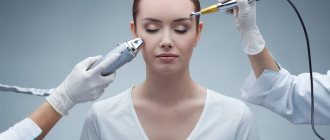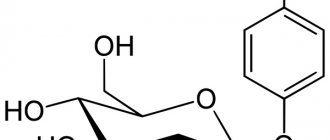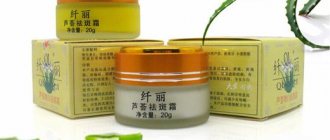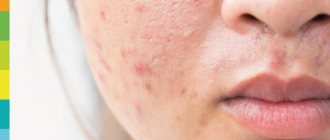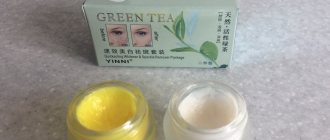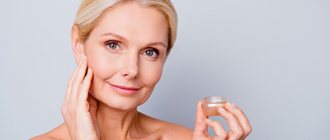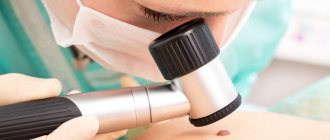Letidora expert, Sofya Igorevna Avanesyants, cosmetologist, dermatovenereologist at the SM-Cosmetology clinic (@sm_krasota), will help you figure out whether home cosmetics can really whiten age spots and how it works.
Sofya Igorevna Avanesyants, cosmetologist, dermatovenerologist at the SM-Cosmetology clinic
Before we talk about whitening cosmetics, it is important to understand how skin spots occur.
Where do pigment spots come from?
Pigment formation is a complex process that involves many factors (for example, excessive melanin production and its uneven distribution on the skin surface).
The cosmetologist at the clinic strives to identify the cause of the spots in order to find the right solution. However, no method can guarantee 100% results. Skin whitening cosmetics, as a rule, are not able to cope with age spots alone.
Therefore, in order to increase the chances of success, doctors combine in-clinic procedures with home care.
Chatterbox - composition
This drug has a beneficial effect on the condition of the skin. This effect is achieved due to the fact that a face wash for acne, purchased at a pharmacy or made with your own hands, may contain the following components:
- medical (ammonia or camphor) alcohol, which disinfects the skin;
- boric acid, which is an antiseptic;
- sulfur is a substance with an antimicrobial effect that helps cope with subcutaneous mites;
- salicylic acid – a disinfectant that promotes wound healing;
- tincture of medicinal herbs (chamomile, sage, calendula) - a component that has an anti-inflammatory effect;
- Dimexide is a conductor of active components.
How do professionals treat pigmentation?
During the course of procedures carried out in the clinic, doctors first of all prescribe restorative, sedatives, and also during daylight hours, sunscreen with a high SPF, from 30 to 50.
At the end of the course, in winter, the cosmetologist will select a cream with retinol or fruit acids in low concentration, and in the summer - serum with vitamin C, the content of which is at least 10%.
The doctor also prescribes the intake of antioxidants - such as vitamin C, E, ubiquinone, bioflavonoids.
Upon completion of the first stage (course of procedures), cosmetologists prescribe the second stage - home care, which works in two directions: exfoliating procedures aimed at renewing the skin and reducing the production of melanocytes - pigment-producing cells.
The frequency of application of bleaching agents depends on the concentration of the substance contained in them.
They can be used daily or once a week at night. The duration of the course is determined by the doctor.
What does chatter help with?
There are many options for such a suspension. The effect of using this medicine directly depends on what components are in the mash.
Traditionally, the suspension has the following positive properties:
- The composition moderately dries out the skin.
- This liquid for acne on the face helps and minimizes the risk of relapse.
- It has a local antiseptic effect on the affected area of the skin.
- Has a tonic effect.
- Stimulates the regeneration of damaged tissues.
- Provides vitamin and mineral nutrition to skin cells.
About mass market and traditional medicine
Folk remedies for removing age spots are innumerable: it is recommended to apply parsley infusion, lemon juice, masks made from black currants, cottage cheese, raw potatoes to problem areas...
For extreme sports enthusiasts, an exclusive option is offered, such as a honey mask with fish oil. Is all this effective?
Plant extracts and acids found in folk skin whitening remedies can actually provide gentle and gradual lightening, as well as improve the overall condition of the skin. However, they are not intended to treat serious problems such as melasma (benign skin pigmentation disorder) or lentigo (brown patches).
In addition, folk remedies can cause an allergic reaction and skin irritation, so they must be used with caution.
As for cosmetics from the mass market, despite advertising promises, they are ineffective.
The active substances that provide the whitening effect are in very low dosages, which is why such products are inexpensive. However, using this cosmetics, it is impossible to achieve a therapeutic effect.
Causes of redness
The origin of the pathology of rosacea is still not entirely clear. The disease is associated with various factors. The immune system, diseases of capillaries and blood vessels, and skin microorganisms play a role in its occurrence.
Redness occurs due to external factors:
- addiction to tanning;
- frost or heat;
- love of alcohol:
- taking hot drinks;
- an abundance of spicy food;
- use of low-quality cosmetics.
Such reasons affect the tone of facial vessels, causing them to dilate and provoke rosacea.
Scientists have not proven the effect of a genetic factor, but in 40% of patients with rosacea, similar rashes appear in close and distant relatives. Redness on the face occurs due to hormonal “stress”: menstruation, menopause, endocrine diseases. The effect of other internal factors on the development of the disease is also considered:
- With “rosacea”, pustular rashes are possible. Typically, such manifestations are associated with the “work” of bacteria. But when studying the purulent contents, no microorganisms were found, which indicates the absence of infection.
- In a number of patients, when scraping the redness, larvae of mites of the genus Demodex were found, which provoke rosacea. But this “mite infestation” does not apply to all patients.
- In case of improper functioning of the gastrointestinal tract (gastritis, colitis, inflammation of the intestines), 50% of people develop rosacea. Poor functioning of the digestive tract provokes the disease.
- Nervous disorders associated with a “broken” psyche can also cause redness. Just looking in the mirror at your red face can cause a nervous shock.
- Uncontrolled use of medicines. Taking antibiotics and hormonal drugs without medical advice can cause skin disease.
Other reasons can be named. If there is a disturbance in vascular tone, lymph circulation, malfunction of the sebaceous glands, or malfunction of the immune system, redness is also possible.
Important! You should not take independent action and remove rosacea on your own, using a home first aid kit or folk remedies. First, you should understand the causes of rosacea, and only then treat it under the supervision of a dermatologist.
About pharmacy and professional products
Pharmacy and professional skin whitening products include azelaic, kojic, ascorbic acids, as well as arbutin and retinol.
These are drugs with a higher concentration of active substances, unlike mass market products. Pharmacy and professional products reduce the production of melanocytes and also provide antioxidant protection.
Products in the photo: nourishing regenerating cream against age spots, Dr Pierre Ricaud; whitening corrector, Jane Iredale; concentrate ampoules for radiance and smoothness of the skin Vitamin C+, BABE Laboratorios; Fresh Tone brightening alginate mask with vitamin C, SmoRodina; brightening gel face mask with bergamot and lemon, KIKO MILANO; con, Institut Esthederm; ampoules for the correction of photoaging, Platinum Photo-Age, MartiDerm; serum with a high content of vitamin C Cyber C, Mimi Luzon; ampoule course for skin tone correction, Doctor Babor
In addition to external preparations (creams, masks, etc.), pharmaceutical and professional products include dietary supplements that contain vitamins C, B12, B1, B2, zinc and amino acids. These substances provide antioxidant protection to the skin, thereby reducing the likelihood of relapses. However, you should not buy such products yourself, focusing only on the instructions, recommendations from friends or reviews on the Internet. It is best to consult with a cosmetologist who will select suitable medications and a regimen for their use.
Sometimes peelings are used to whiten the skin. These are products based on retinol, kojic, lactic or trichloroacetic acid.
Products pictured: skin brightening lotion, Guinot; sunscreen gel-cream for skin with pigmentation and signs of aging SPF50, Bioderma; facial toner with lemon extract Lemon' C, It's Skin; intensive concentrated anti-aging care Redermic Retinol C, La Roche-Posay; moisturizing essence that evens out skin tone, Coscodi; sunscreen cream-gel for skin radiance SPF50+, NARIS Parasola; whitening lotion, preventing pigmentation, HADALABO; dipigmenting cream-gel, Azelac RU, Sesderma; brightening serum C-12 Pure Bright Serum, Dermalogica; essence-concentrate for skin radiance Vinoperfect, Caudalie; global anti-aging serum AH3 with vitamin C, Topicrem; anti-pigmentation serum, Uriage; brightening serum against age spots, EGIA
Also, two-phase peelings have now appeared that contain a complex of acids, including hyaluronic acid, and amino acids. This peeling will lighten the skin without drying it out and will additionally create a lifting effect.
But peelings work if the pigment is located in the superficial layer of the epidermis, that is, not deep.
Preventive measures
When dealing with pigmentation, it is important to understand that removing brown spots through medications, cosmetic procedures and products is only half the battle. If the original cause of melanin imbalance has not been eliminated or there is a tendency to develop pigmentation, the benefits of treatment will be short-lived. To prolong the effect or get rid of unpleasant spots on the face forever, it is important to properly care for your skin and follow preventive measures.
It is necessary to constantly protect your face from exposure to ultraviolet radiation, especially in the spring and summer, when the sun is especially dangerous, and to abandon the solarium for good. Do not leave the house in the morning or afternoon without sunscreen, and on especially sunny summer days, additionally wear a wide-brimmed hat.
Monitoring your health is also necessary, especially hormonal levels, nervous system, reproductive system, liver and gall bladder. For any deviations, it is important not to delay treatment.
To eliminate and prevent age spots, it is worth avoiding, if possible, any hormonal medications, including contraceptives, since studies have confirmed the influence of the latter on the level of melanin and its improper distribution in the skin.
The lack of vitamins and other nutrients has a great impact on the level of melanin and, as a result, the development of pigmentation. That is why it is important that the body constantly receives vitamins A, E, PP, C and B9 from food or vitamin complexes. A balanced diet is the path to healthy skin. It is advisable to include in your diet foods such as bell peppers, beef liver, citrus fruits, carrots, vegetables, herbs, eggplants and jacket potatoes. It is recommended to use polyunsaturated fatty acids and selenium as supplements in courses.
Why do you need to consult a cosmetologist?
There are no universal whitening products.
They must be selected individually for each patient. The cosmetologist takes into account skin type and sensitivity, lifestyle and even climatic conditions. For example, doctors cannot prescribe long-term use of fruit acids or retinol to a patient who regularly flies to hot countries or lives on the coast. In this case, antioxidants and adequate photoprotection are selected.
All active products for working with hyperpigmentation are prescribed strictly in the autumn-winter time, otherwise you can get the opposite effect.
When choosing a product according to the description, you do not always have the necessary information about what is and is not advisable to use. This is why independent use of professional or pharmacy products can lead not to whitening, but to serious problems.

